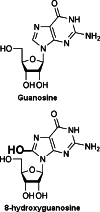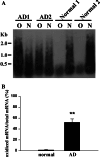Oxidative damage to RNA: mechanisms, consequences, and diseases
- PMID: 20148281
- PMCID: PMC3010397
- DOI: 10.1007/s00018-010-0277-y
Oxidative damage to RNA: mechanisms, consequences, and diseases
Abstract
Overproduction of free radicals can damage cellular components resulting in progressive physiological dysfunction, which has been implicated in many human diseases. Oxidative damage to RNA received little attention until the past decade. Recent studies indicate that RNA, such as messenger RNA and ribosomal RNA, is very vulnerable to oxidative damage. RNA oxidation is not a consequence of dying cells but an early event involved in pathogenesis. Oxidative modification to RNA results in disturbance of the translational process and impairment of protein synthesis, which can cause cell deterioration or even cell death. In this review, we discuss the mechanisms of oxidative damage to RNA and the possible biological consequences of damaged RNA. Furthermore, we review recent evidence suggesting that oxidative damage to RNA may contribute to progression of many human diseases.
Figures




Similar articles
-
The role of iron and copper in the aetiology of neurodegenerative disorders: therapeutic implications.CNS Drugs. 2002;16(5):339-52. doi: 10.2165/00023210-200216050-00006. CNS Drugs. 2002. PMID: 11994023 Review.
-
RNA oxidation: a contributing factor or an epiphenomenon in the process of neurodegeneration.Free Radic Res. 2008 Sep;42(9):773-7. doi: 10.1080/10715760802311187. Free Radic Res. 2008. PMID: 18661427 Review.
-
Metal ions and oxidative protein modification in neurological disease.Ann Ist Super Sanita. 2005;41(2):143-64. Ann Ist Super Sanita. 2005. PMID: 16244388 Review.
-
RNA oxidation in Alzheimer disease and related neurodegenerative disorders.Acta Neuropathol. 2009 Jul;118(1):151-66. doi: 10.1007/s00401-009-0508-1. Epub 2009 Mar 7. Acta Neuropathol. 2009. PMID: 19271225 Review.
-
Metals and free radicals in neurodegeneration.Curr Opin Neurol. 1994 Dec;7(6):548-58. doi: 10.1097/00019052-199412000-00013. Curr Opin Neurol. 1994. PMID: 7866588 Review.
Cited by
-
Ionizing radiation responses appear incidental to desiccation responses in the bdelloid rotifer Adineta vaga.BMC Biol. 2024 Jan 25;22(1):11. doi: 10.1186/s12915-023-01807-8. BMC Biol. 2024. PMID: 38273318 Free PMC article.
-
Role of Oxidative RNA Damage in Chronic-Degenerative Diseases.Oxid Med Cell Longev. 2015;2015:358713. doi: 10.1155/2015/358713. Epub 2015 May 20. Oxid Med Cell Longev. 2015. PMID: 26078805 Free PMC article. Review.
-
MicroRNA and Oxidative Stress Interplay in the Context of Breast Cancer Pathogenesis.Int J Mol Sci. 2019 Oct 17;20(20):5143. doi: 10.3390/ijms20205143. Int J Mol Sci. 2019. PMID: 31627322 Free PMC article. Review.
-
A study on UHPLC-MS/MS analyses of DNA and RNA oxidative damage metabolites in patients with cervical carcinoma: 8-oxoG in urine as a potential biomarker of cervical carcinoma.Heliyon. 2022 Apr 25;8(4):e09321. doi: 10.1016/j.heliyon.2022.e09321. eCollection 2022 Apr. Heliyon. 2022. PMID: 35520626 Free PMC article.
-
Redox signaling regulates skeletal muscle remodeling in response to exercise and prolonged inactivity.Redox Biol. 2022 Aug;54:102374. doi: 10.1016/j.redox.2022.102374. Epub 2022 Jun 17. Redox Biol. 2022. PMID: 35738088 Free PMC article. Review.
References
-
- Muller FL, Lustgarten MS, Jang Y, Richardson A, Van Remmen H. Trends in oxidative aging theories. Free Radic Biol Med. 2007;43:477–503. - PubMed
-
- Fearon IM, Faux SP. Oxidative stress and cardiovascular disease: novel tools give (free) radical insight. J Mol Cell Cardiol. 2009;47:372–381. - PubMed
-
- Cederbaum AI, Lu Y, Wu D. Role of oxidative stress in alcohol-induced liver injury. Arch Toxicol. 2009;83:519–548. - PubMed
Publication types
MeSH terms
Substances
Grants and funding
LinkOut - more resources
Full Text Sources
Other Literature Sources
Miscellaneous

